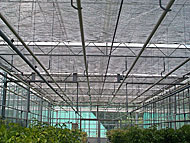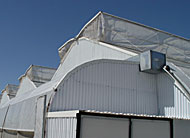
Greenhouse screens
There are a number of different materials in this category. In broad terms they can be divided into thermal screens, insect screens and shade screens. Thermal screens will probably be the most useful piece of equipment after the greenhouse itself, the hydroponic system, the heating system and the automated control system.
Thermal screens

Thermal screens offer a flexible and efficient way of improving the management of the greenhouse environment. These screens are designed to keep heat and radiation in a greenhouse during cold periods such as night time and prevent radiation and associated heat entering the greenhouse during hot periods, such as in the middle of a summer day.
This dual capacity makes these materials suitable to a range of conditions throughout the year. They are moveable so that conditions can be adjusted and optimised through out the day and night. Thermal screens can reduce temperatures during the day by as much as 10˚C and maintain temperatures during the night by as much as 5˚C.
When heating, thermal screens trap warm air nearer the crop, reduce the volume of air space to be heated and reflect radiation back to the crop. This can reduce heating costs significantly – possibly by up to half.
Under extreme, hot conditions, thermal screens are also valuable in reducing incoming radiation during the day. This reduces the heat load in the greenhouse and assists in maintaining humidity around the plants and reducing plant stress.
The use of screens needs to be carefully managed to make sure that plants remain actively growing.
Shade screens
Shade cloth provides some of the functions of thermal screens. Under extreme, hot conditions, shading reduces the amount of incoming radiation. This in turn reduces the heat load in the greenhouse and assists in maintaining humidity around the plants and reducing plant stress. The use of shade cloth for cooling is most effective when the material is used outside of the greenhouse.
If shade screens are used, pale coloured materials should be selected as these uniformly reflect solar radiation and do not absorb as much heat themselves as darker materials. A range of products offer shading from 30% up to almost total blackout.
Whitewash paints are another shading option that can be applied to reduce the amount of radiation entering the greenhouse. White-wash is a lime wash or diluted paint applied to the outside of the greenhouse covering. It reduces the amount of solar radiation entering the greenhouse and therefore reduces temperature. The disadvantage of this type of screen is that it is applied seasonally, such as at the beginning of summer and consequently is not be readily adjusted for changing conditions from day to day or during a day. This results in reduced light levels even when temperature reduction is not needed. The end effect can be quite significant reductions in light levels and consequently yield. There are white wash products available which become transparent when wet so as to allow more light in during rain periods. During warm overcast conditions, these products can be hosed down to increase light transmission.
Insect screens

Insect screens are used to exclude flying and wind-borne pests from the greenhouse.
The main disadvantage of insect screens is that they restrict airflow. This can have a significant impact on venting capacity of a structure. The size of the hole is the key characteristic that determines whether or not it can prevent a pest from getting into the structure. However, the finer the screen, that is, the smaller the hole size, the less air that can flow through it.

